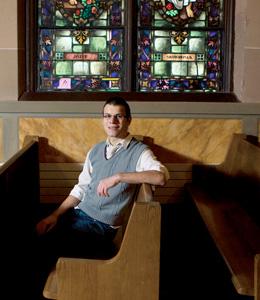By Katherine Duke '05
 "I started going to Mass three times every Sunday morning," says Phil Dupont '12 of his semester-long project on the music of a changing Catholic Diocese. |
When Phil Dupont ’12 first heard that the Catholic Diocese in Springfield, Mass., would merge Holy Cross, an Irish-American parish in Holyoke, Mass., with Mater Dolorosa, a bilingual parish serving that city’s Polish immigrant community, he wondered what the change would be like for parishioners.
Not long after, when he enrolled in the course Music 19: “Pioneer Valley Soundscapes,” he started to wonder what the change would sound like.
“I started going to Mass three times every Sunday morning,” Dupont said, as he stood at the podium in Pruyne Lecture Hall on Dec. 10, 2009, and presented his semester-long project, “Our Lady of Sorrows Sings On: The Sounds of Catholic Worship in Holyoke.”
The project includes extensive video footage of clergy and worshippers at both churches praying, singing and discussing, in both Polish and English, the histories and futures of the parishes, as well as a description of the ways that Mater Dolorosa helps to reinforce its members’ Polish identity.
“Pioneer Valley Soundscapes” grew out of Assistant Professor of Music Jeffers Engelhardt’s idea for an ethnomusicology course that would consist primarily of anthropological fieldwork. The seven students in last fall’s inaugural semester did first-hand research on local “musical communities and acoustic terrain” to investigate “the connection between sound and place.”
For example, Tom Sibley ’10 and Ashley Soto ’11 visited the Santiago Family Restaurant in Westfield, Mass., to listen to the family band that performs there every weekend. They also interviewed master luthier William Cumpiano from the workshop in Northampton, Mass., where he builds traditional Puerto Rican instruments. Their multimedia project, “A Taste of Music in the Pioneer Valley’s Puerto Rican Community,” relied on Soto’s fluency in Spanish and Sibley’s skill with cameras and computers.
The course represents close collaboration between the music department, the Center for Community Engagement—which helped provide transportation and funding for the fieldwork—and the information technology department, which helped design the course’s new Web site, pioneervalleysoundscapes.org. The students’ final projects, which featured text, audio and video, are now posted to the site, and Engelhardt expects to add new student projects every semester. “I see this Web-based archive becoming this ever-expanding resource for students at Amherst [and] community members,” he says.
Many of the musicians and experts with whom the students worked were in attendance at the final presentations.
When it was her turn at the podium, Deidra Montgomery ’10 described her experience with a group that gathers in a Smith College chapel every Tuesday night to participate in a choral singing tradition called Sacred Harp. “I first started recording just the singing,” she said, “but then I realized that I actually needed to talk to people about it and see what they feel about it.” At the end of the hour of presentations, at Montgomery’s invitation, a few classmates and others in the audience stood up with her, formed a circle at the front of the room, and sang.
Photo by Alec Jacobson '12